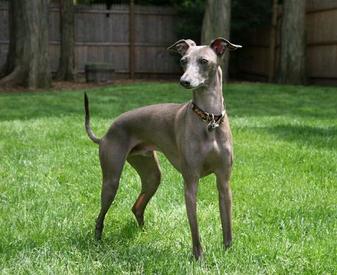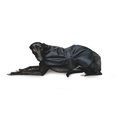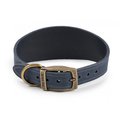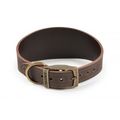
The smallest of the sight hounds, the Italian Greyhound derives its name from its centre of early popularity, Renaissance Italy. Thought to have originated as long as 2,000 years ago, the breed was primarily bred as a companion dog, highly prized for its amiable temperament and energy. In its early existence, the Italian Greyhound was a favourite in the royal courts of Europe, appearing to Queen Anne of Denmark, Catherine the Great of Russia, James I and Queen Victoria of England. Despite being originally bred as a companion dog, the Italian Greyhound was otherwise utilised in hunting vermin, helping to rid the home and farmstead of rats. The breed's popularity has fluctuated throughout its existence, although it has become increasingly favoured in more recent years. Officially recognised by the AKC in 1886.
Small and lean in build, the Italian Greyhound possesses a distinctive appearance, closely resembling the English Greyhound in all but size. Boasting short legs, a deep chest for enhanced lung capacity, a long and pointed muzzle, a tapering tail, and a short, close coat. Typically, the coat is observed in colours of slate grey, fawn, red, cream, white, black or blue. White markings are permitted on the feet and chest, whilst black and tan or brindle varieties are not accepted in the show ring. Agile and curious, the Italian Greyhound is capable of climbing to a considerable height so observation is necessary when off the leash.
Contrary to popular belief, the Italian Greyhound is an amiable, relaxed and gentle breed, with a quiet temperament that enjoys regular human contact. The Greyhound is neither aggressive nor highly strung, but docile and dependable towards its owners. Compatible with children and other house pets when introduced to them gradually, the breed is low maintenance and makes a great addition to any home setting. Whilst there are discrepancies across gender, the average Italian Greyhound will weigh between 3-5 kg, with a life expectancy of approximately 12-15 years when shown appropriate care.
Typically the Italian Greyhound is a healthy, long-lived breed, however, its unique physique makes it susceptible to certain health complaints. Greyhounds do not have undercoats and are subsequently more vulnerable to skin sores and irritation; they are particularly unsuited to the use of insecticides, particularly those that are pyrethrin-based. The Greyhound's lack of undercoat and general body fat makes the breed susceptible to extreme temperatures, so it is essential they are always housed indoors. Additionally, the Italian Greyhound is susceptible to optical disorders, orthopedic complaints, hormonal disease, and von Willebrand's Disorder.








From Dorset, United Kingdom
Mad as a bag of frogs, a great little dog , loves to hunt , birds , rats , mice and squirrels , they love to bring in the gifts to you, will eat all food plus some , watch their weight!!
Sorry just forgot they love your duck duvet as much as you do so watch out